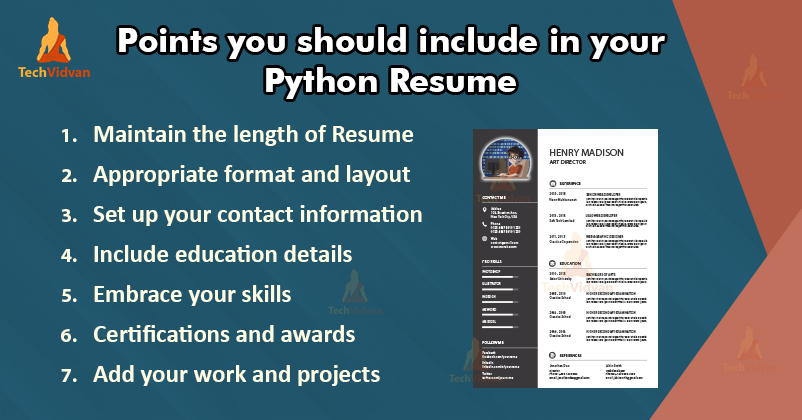Python Resume – 7 Points You Should Include In Your Python PortFolio
The demand for Python developers has grown exponentially over the past few years. This field has now become competitive. Entering this competitive field is not that easy. You have to face many challenges. One of those challenging tasks is building your Resume. Let us see how to make an impressive Python Developer Resume.
Python Developer Resume
A Resume is a medium to convey your skills, talent, abilities, capabilities, etc to the employer. With the help of a Resume, you can advertise yourself and showcase yourself. This is the first mode of communication that you use to present yourself in front of the prospect’s employer. Resume will help you to prove yourself the best choice to your employer.
Prepare your Resume such that it leaves a long-lasting impression on the employer. Your Resume must give your first imprint that you are the best-fit choice for the job you have applied. Your goal is to build a resume that doesn’t end up in waste. It must be attractive enough that you get an instant call. To make your resume efficient, the following points mentioned below:
1. Maintain the Length of Resume
Keep your resume brief. It should be short and simple. The Resume should neither be too large nor be too small. Avoid adding long paragraphs and large chunks of information in your Resume. Decorate your resume with all your talent, skills, abilities, capabilities, experiences, etc sweetly and simply. Better to describe information in bullets.
Make sections wherever possible. This increases the readability of the content. Limit your resume to a maximum of 2 pages. Any resume beyond 2 pages increases your chances to get rejected.
2. Choose the Appropriate Format and Layout
There are two formats that are appropriate for Python’s resume.
- Functional layout – It is more focused on your skills, not on your story.
- Reverse Chronological layout – It emphasizes your work experiences as a timeline.
Reverse Chronological layout is preferred as it will include all your work experiences. Most of the recruiters are rejected because of inappropriate font, color, design, format, etc. Black is a commonly accepted color for resume. Remember the header section.
Also, remember to customize your resume according to each Python field you are applying to. Research about the company. Before building a resume make sure you know about the company you are applying in. Your resume should be different for each application you file. Also, remember that your resume should fulfill the given job description.
3. Set up your Contact Information
Make your contact information easily approachable. If an employer decides to contact you based on your Python resume, don’t make search more. Don’t forget to include your mobile number, email-id, and address. Update your resume if you change any of your contact information. Also, add a link to your online portfolio and your LinkedIn profile.
4. Include Appropriate Education Details
Mention your educational background. If it is not relevant to your application still mention it. Many industries give preferences to your educational background. So, include your education details preciously. Mention your higher qualification degree on the top and your lower qualifications at the lower levels.
5. Embrace your Skills
Include your skills which will create an impressive impact on the employer. Skill is the important section in the Python resume. Employers look for skilled employees. Include your skills in an eye-catchy way. Focus on technical skills. Make sure that you highlight words related to Python like data science, machine learning, artificial intelligence, etc. Also, don’t limit to technical skills because your soft skills also matter. Employers are also interested in your communication skills. Your resume must have a balance of both soft skills and technical skills.
6. Mention Certifications and Awards
Create a separate section for your awards and certifications. It is a more important section. Specify your training certifications. Forget not to mention your Python certifications. This creates your unique impression. This makes the employer focus on your ability to learn. This will help the employer to think that it isn’t an ordinary resume. Reflect your awards and your achievements in the resume.
7. Add your Work Experience and Python Projects
It is one of the most important sections. Projects will add color to your resume. List all the projects are done during your past and current job. Remember to add details like for whom the project was made, the scale of the project, platform used in the project, etc. Maintain the chronological order, ie, most recent job on the top. Look at the projects you have done and select one that fits the application. Better not to include experiences and projects that not related to Python.
Conclusion
A resume is an important part of your application. An effective and impressive Python resume will enable the employer to identify you uniquely. To create a good resume, focus on the recruiters’ point of view. A resume will help the employer understand that you can handle the position you are applying for. So, build your Python resume according to the above-mentioned points and make your way to the interview.

